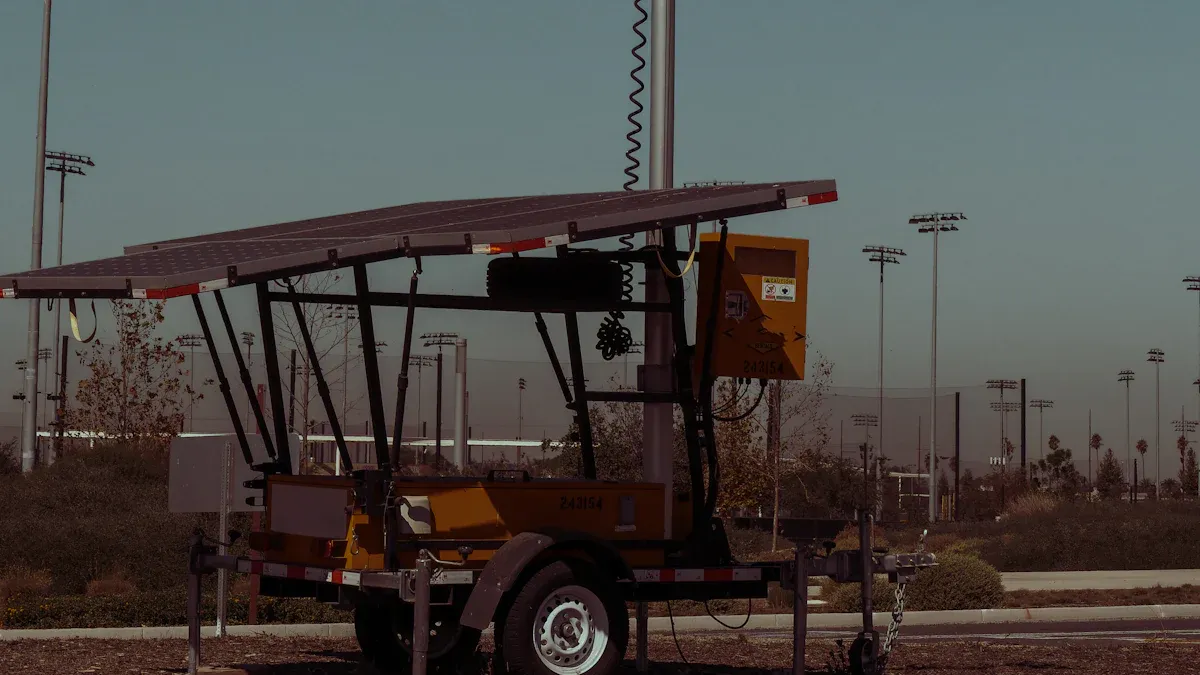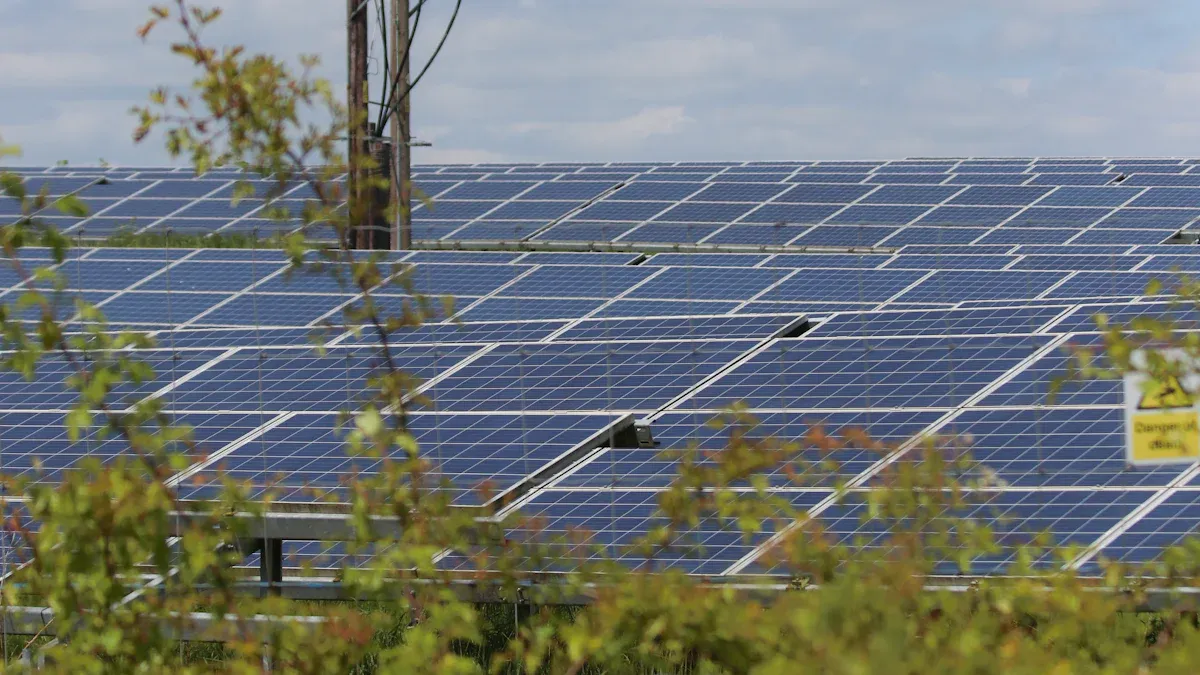User Experiences with Top Solar Systems for Telecom Towers

Industry experts recognize SunPower Maxeon, Canadian Solar HiKu, and Trina Solar Vertex as leading choices when selecting a solar system for telecom tower applications. Users consistently praise these solutions for their reliability and high output. Many value systems that require minimal upkeep and deliver consistent performance. The best solar panels often earn recommendations due to proven efficiency and robust design. User experiences serve as a vital guide, helping decision-makers choose the best solar panels and the most suitable solar system for telecom tower operations.
Key Takeaways
Solar power provides reliable backup energy for telecom towers, reducing outages and saving costs on fuel and maintenance.
Choosing high-quality solar panels like SunPower Maxeon, Canadian Solar HiKu, or Trina Solar Vertex ensures strong performance and long-term reliability.
Regular maintenance and proper installation are essential to keep solar systems working well and to protect them from weather and theft.
Operators should match solar system size and battery backup to their tower’s energy needs and plan for future expansion.
Combining solar panels with battery storage and generators creates a dependable power backup that keeps telecom towers running during outages.
Importance of Solar Power for Telecom Towers

User Benefits
Telecom tower operators increasingly rely on solar energy to ensure continuous service. Solar systems deliver reliable backup power, especially in regions where the grid remains unstable. Many users report that solar solutions reduce the risk of power outage, which can disrupt communication networks. Operators value the ability to maintain connectivity during an outage, thanks to dependable backup systems. Solar installations often include battery storage, providing backup even when sunlight is unavailable. This approach guarantees that telecom towers have backup power ready at all times. Users also highlight the cost savings from reduced fuel consumption and lower maintenance needs. Solar energy systems require less frequent intervention, which means fewer site visits and lower operational costs. The environmental benefits also appeal to many operators, as solar energy reduces carbon emissions and reliance on fossil fuels.
Note: Many users consider solar-powered backup systems essential for remote or off-grid telecom towers, where emergency backup power can prevent service interruptions.
Common Challenges
Despite the advantages, users face several challenges when deploying solar systems for telecom towers. Weather variability can impact solar output, making it difficult to guarantee backup during extended cloudy periods. Some operators experience issues with battery degradation, which affects the reliability of backup power. Regular maintenance becomes necessary to ensure the backup system functions during a power outage. Users also report that initial installation costs can be high, although long-term savings often offset these expenses. Theft and vandalism pose risks to solar panels and backup batteries, especially in isolated locations. Operators must implement security measures to protect their investment and maintain consistent backup availability. During a prolonged outage, the backup system may require additional support from generators or other sources to keep the tower operational.
Challenge | User Impact |
|---|---|
Weather Variability | Reduced backup reliability |
Battery Degradation | Lower backup power availability |
High Initial Costs | Delayed return on investment |
Security Risks | Potential loss of backup equipment |
Extended Outages | Need for extra backup solutions |
Key Factors for Choosing a Solar System for Telecom Tower
Reliability and Uptime
Reliability stands as a top priority for telecom operators. They need a solar system for telecom tower sites that can deliver consistent power, even in harsh environments. Many users report that high-quality components and robust system design help maintain uptime. Reliable systems reduce the risk of dropped calls and network outages. Operators often select products with proven track records in the field.
Tip: Users recommend choosing systems with built-in monitoring to quickly detect and resolve issues.
Efficiency and Output
Solar panel efficiency directly impacts the amount of energy generated. Higher efficiency panels produce more power from the same amount of sunlight. Users often compare products based on solar panel efficiency ratings. They find that efficient panels allow for smaller arrays, which saves space at crowded tower sites. In regions with limited sunlight, high solar panel efficiency ensures stable operation. Operators also note that efficient panels reduce the need for frequent upgrades.
Panel Type | Typical Efficiency (%) |
|---|---|
Monocrystalline | 19-23 |
Polycrystalline | 15-18 |
Thin-Film | 10-13 |
Installation and Maintenance
A smooth solar installation process reduces downtime and labor costs. Users prefer systems with modular designs, which simplify setup and future expansion. They also value clear instructions and strong technical support. Regular maintenance keeps the system running at peak performance. Many operators choose products with self-cleaning features or easy-access panels. These features minimize site visits and lower long-term costs.
Cost and ROI
Cost remains a major factor in decision-making. Operators look at both upfront expenses and long-term savings. A solar system for telecom tower applications often requires a significant initial investment. However, users report that lower fuel costs and reduced maintenance lead to a strong return on investment. They recommend calculating payback periods and considering incentives for solar installation projects.
Best Solar Panels for Telecom Towers

SunPower Maxeon Series
SunPower Maxeon Series panels stand out as some of the best solar panels for telecom towers. These panels use advanced monocrystalline technology, which delivers high efficiency and durability. Many users report that Maxeon panels maintain strong performance even in harsh weather. Operators often choose this series for sites that demand maximum uptime and minimal maintenance.
User Experiences:
Operators praise the Maxeon Series for its consistent output and long lifespan.
Many users highlight the robust frame and resistance to microcracks, which helps reduce maintenance needs.
Some users mention the higher upfront cost, but most agree that the long-term savings justify the investment.
Case Study:
A telecom provider in Southeast Asia installed Maxeon panels at remote tower sites. The company reported a 30% reduction in site visits for maintenance. The panels worked seamlessly with solar generators and battery backup systems, ensuring reliable service during monsoon seasons.
Note: Users often recommend pairing Maxeon panels with high-quality solar battery solutions to maximize backup power.
Performance Highlights:
High efficiency (up to 22.8%) supports smaller arrays at space-limited sites.
Strong compatibility with solar generators and battery backup systems.
Proven reliability in extreme climates.
Canadian Solar HiKu Series
Canadian Solar HiKu Series panels have earned a reputation as some of the best solar panels for telecom tower applications. These panels offer a balance of efficiency, affordability, and durability. Many operators select HiKu panels for projects where budget and performance both matter.
User Experiences:
Users appreciate the competitive price point and solid energy output.
Many operators report easy integration with existing solar generators and battery backup setups.
Some users note that HiKu panels require regular cleaning in dusty environments to maintain peak performance.
Testimonial:
A network operator in Africa deployed HiKu panels across 50 rural telecom towers. The operator observed a 25% drop in generator fuel costs and improved uptime due to reliable battery backup. The panels performed well even during extended cloudy periods, thanks to their strong low-light response.
Performance Highlights:
Efficiency ratings up to 21% make HiKu panels a top choice for the best solar panels in telecom.
Durable design withstands wind and heavy rain.
Seamless operation with solar generators and battery backup systems.
Trina Solar Vertex Series
Trina Solar Vertex Series panels rank among the best solar panels for telecom towers, especially for high-capacity sites. These panels feature large cell designs and advanced interconnection technology. Many users select Vertex panels for towers that require high power output and robust battery backup.
User Experiences:
Operators value the high wattage output, which supports more equipment with fewer panels.
Many users report smooth integration with solar generators and battery backup systems.
Some users mention the panels’ size can pose installation challenges at compact sites.
Case Study:
A telecom company in South America upgraded its solar system for telecom tower sites using Vertex panels. The company achieved a 40% increase in solar energy production. The new setup reduced reliance on diesel solar generators and improved battery backup reliability during grid outages.
Tip: Users recommend professional installation for Vertex panels to ensure optimal alignment and performance.
Performance Highlights:
Output ratings up to 670W per panel place Vertex among the best solar panels for large-scale telecom projects.
Excellent compatibility with solar generators and advanced battery backup systems.
Strong performance in both high-temperature and low-light conditions.
Comparison Table:
Panel Series | Max Efficiency (%) | Max Output (W) | Durability | User-Rated Pros | User-Rated Cons |
|---|---|---|---|---|---|
SunPower Maxeon | 22.8 | 440 | Excellent | High efficiency, low upkeep | Higher upfront cost |
Canadian Solar HiKu | 21 | 590 | Very Good | Affordable, easy integration | Needs regular cleaning |
Trina Solar Vertex | 21.6 | 670 | Excellent | High output, robust design | Large panel size |
Choosing the best solar panels for telecom towers depends on site requirements, budget, and the need for reliable battery backup and solar generators.
Comparing Top Solar System Products
Strengths and Weaknesses
Users often compare the best solar panels for telecom towers by looking at real-world performance. SunPower Maxeon panels deliver high efficiency and long-term durability. Many operators report that these panels provide reliable backup power and require little maintenance. However, the higher cost can challenge budget-conscious projects. Canadian Solar HiKu panels offer a balance between affordability and solid output. Users appreciate their easy integration with solar generators and battery backup systems. Some operators note that these panels need regular cleaning to maintain backup performance, especially in dusty areas. Trina Solar Vertex panels stand out for high wattage and robust design. Operators value their ability to support more equipment with fewer panels, which helps maximize backup power. The larger size can make installation difficult at compact sites.
Product | Strengths | Weaknesses |
|---|---|---|
SunPower Maxeon | High efficiency, low upkeep | Higher upfront cost |
Canadian Solar HiKu | Affordable, easy integration | Needs frequent cleaning |
Trina Solar Vertex | High output, robust design | Large panel size |
Note: Users recommend pairing all three products with advanced battery backup and solar generators to ensure continuous backup power during outages.
Best Fit for Different Needs
Selecting the right solar system depends on the specific backup requirements of each telecom tower. SunPower Maxeon panels suit sites that demand maximum reliability and minimal maintenance for backup. Canadian Solar HiKu panels fit projects where budget and easy integration with solar generators matter most. Trina Solar Vertex panels work best for towers with high power needs and space for larger arrays, ensuring strong backup power and battery backup support.
Operators should assess site conditions, backup power needs, and available space before choosing. Many users suggest consulting with solar experts to match the best solar panels, battery backup, and solar generators for optimal backup performance.
User Tips for Solar System for Telecom Tower
Selection Advice
Operators often share practical advice when selecting a solar system for telecom towers. They recommend evaluating the reliability of backup power solutions. Many users suggest choosing panels with proven performance in harsh environments. Battery backup capacity should match the tower’s energy needs to ensure continuous backup during a power outage. Operators also advise checking compatibility with solar generators and solar battery systems. A thorough site assessment helps determine the best solar installation approach.
Tip: Always consider future expansion. Select a system that allows easy upgrades for additional backup or increased power needs.
Installation Best Practices
Solar panel installation plays a critical role in system longevity. Users recommend hiring certified professionals for solar installation. Proper alignment and secure mounting maximize sunlight exposure and backup power generation. Operators often use modular designs for quick setup and easy maintenance. They also suggest integrating solar generators and battery backup systems during the initial installation. This approach ensures seamless emergency backup power during an outage.
Checklist for installation:
Confirm all backup components are compatible.
Test battery backup and solar generators before going live.
Secure panels against theft and weather damage.
Maintenance Recommendations
Regular maintenance extends the life of backup systems. Operators clean panels frequently to maintain optimal backup power output. They monitor battery backup health and replace aging batteries to prevent emergency backup power failures. Many users install remote monitoring tools to track backup performance and detect issues early. Scheduled inspections help identify potential problems before a power outage occurs.
Note: Operators recommend keeping spare parts for battery backup and solar generators on-site to reduce downtime during an outage.
A well-maintained solar system ensures reliable backup for telecom towers. Consistent care maximizes the return on investment and supports uninterrupted service.
SunPower Maxeon, Canadian Solar HiKu, and Trina Solar Vertex panels receive strong user recommendations for telecom towers. Operators highlight reliable backup, efficient backup power generation, and easy integration with backup systems. Real-world feedback shows that robust backup solutions minimize downtime. User experiences guide decision-makers to select panels that deliver dependable backup in all conditions. Careful evaluation of site needs and backup requirements ensures the best system choice.
FAQ
What maintenance do solar systems for telecom towers require?
Operators clean panels regularly and inspect connections. They monitor battery health and replace aging units. Remote monitoring tools help detect issues early. Routine checks ensure reliable performance and minimize downtime.
How do solar panels handle extreme weather at telecom sites?
Manufacturers design panels with durable frames and weather-resistant materials. Users report strong performance in high winds, heavy rain, and intense sunlight. Proper installation and secure mounting further protect the system from environmental damage.
Can solar systems work with existing backup generators?
Yes, most solar systems integrate with diesel or hybrid generators. Operators often use solar as the primary source and switch to generators during extended outages. This setup ensures continuous power and reduces fuel consumption.
What is the typical payback period for a telecom solar system?
Payback periods usually range from three to six years. Factors include system size, local energy costs, and available incentives. Users often see faster returns in regions with high fuel prices or frequent outages.
Are solar systems scalable for future telecom tower expansion?
Solar systems often feature modular designs. Operators can add panels or batteries as power needs grow. This flexibility supports network expansion without major redesigns or costly upgrades.
See Also
Solar Energy Storage Solutions Designed For Telecom Cabinets
Selecting The Ideal Mount For Outdoor Telecom Cabinets
Latest Innovations Shaping Outdoor Telecom Cabinet Designs
Integrated Solar Inverter And Battery Systems For Telecom Cabinets
Strategies To Achieve Effective Monitoring Of Outdoor Telecom Cabinets
CALL US DIRECTLY
86-13752765943
3A-8, SHUIWAN 1979 SQUARE (PHASE II), NO.111, TAIZI ROAD,SHUIWAN COMMUNITY, ZHAOSHANG STREET, NANSHAN DISTRICT, SHENZHEN, GUANGDONG, CHINA
